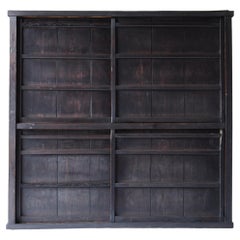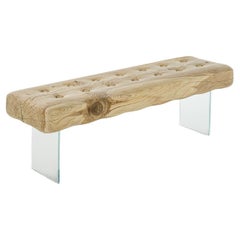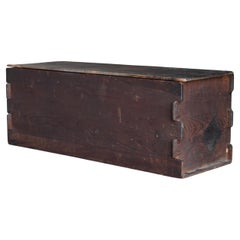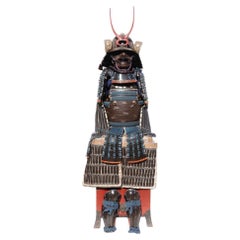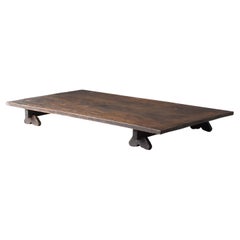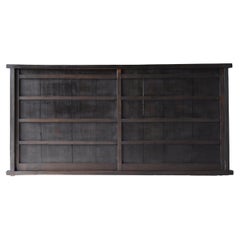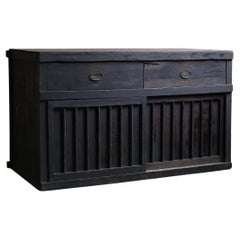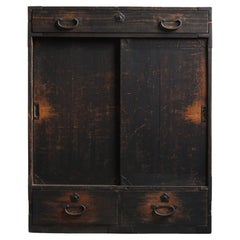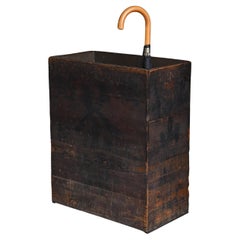Cedar Furniture
to
113
410
329
632
479
10
364
78
20
13
13
11
10
6
2
2
2
1
1
20
142
317
642
117
112
43
7
5
8
11
6
26
27
15
5
2
1,139
357,951
296,317
225,687
151,043
478
364
314
222
217
1,121
524
745
106
88
48
39
21
Material: Cedar
Japanese Antique Large Low Table 1860s-1920s / Sofa Table Dining Table Wabisabi
Located in Chōsei District Nagara, JP
This is a large, old low table made in Japan, dating from the Meiji to Taishō period (1860s–1920s). It is a fine example that strongly reflects the woodworking techniques and aesthet...
Category
Early 20th Century Japanese Taisho Cedar Furniture
Materials
Wood, Cedar
Japanese Antique Wooden Box 1860s-1920s / Sofa Table Storage Box Wabisabi
Located in Chōsei District Nagara, JP
This is an old Japanese wooden box, crafted in the Meiji to Taishō period (1860s–1920s). Despite its long history, it retains a quiet and compelling presence. The box is made from tr...
Category
Early 20th Century Japanese Taisho Cedar Furniture
Materials
Cedar
Japanese Antique Large Black Tansu 1860s-1900s / Sideboard Cabinet Wabi Sabi
Located in Chōsei District Nagara, JP
This is an old large black tansu chest made in Japan. Crafted during the Meiji period (1860s–1900s), it is made from cedar wood, a material known for...
Category
Early 20th Century Japanese Meiji Cedar Furniture
Materials
Cedar
Japanese Antique Large BK Tansu 1860s-1900s / Cabinet Sideboard Wabi Sabi
Located in Sammu-shi, Chiba
This is an antique Japanese Tansu.
Judging by the condition of the metal parts, it appears to be quite old, likely dating to the Edo period.
It has been carefully maintained to pres...
Category
Mid-19th Century Japanese Edo Antique Cedar Furniture
Materials
Cedar
Japanese BK Tansu 1920-1940 / Showa Period / Cabinet Sideboard Wabi sabi
Located in Sammu-shi, Chiba
This is an antique Japanese Tansu.
The patina developed over time is truly exquisite.
It has been meticulously maintained to preserve its patina.
The doors operate smoothly.
It is i...
Category
Early 20th Century Japanese Showa Cedar Furniture
Materials
Cedar
Japanese Antique Umbrella Stand 1900s-1940s / Wabi Sabi
Located in Chōsei District Nagara, JP
This is an old Japanese umbrella stand, crafted in the early Shōwa period (1900s–1940s). Its presence reflects the practical, understated beauty of everyday furnishings from that era...
Category
Mid-20th Century Japanese Showa Cedar Furniture
Materials
Tin
Japanese Antique Black Tansu 1860s-1900s / Sideboard Storage Cabinet Wabisabi
Located in Chōsei District Nagara, JP
This is an antique Japanese black tansu chest, crafted in the Meiji period (1860s–1900s). It is made from sugi (cedar) wood. Its understated and unem...
Category
Early 20th Century Japanese Meiji Cedar Furniture
Materials
Cedar
Japanese Antique Drawer Chest 1860s-1920s / Tansu Sideboard Wabi Sabi
Located in Chōsei District Nagara, JP
This is an antique Japanese drawer chest, crafted in the Meiji to Taishō period (1860s–1920s). It carries a quiet presence shaped by many decades of use. The piece is made from tradi...
Category
Early 20th Century Japanese Meiji Cedar Furniture
Materials
Iron
Japanese Antique Wabi Sabi Small Tansu 1860s-1900s / Cabinet Nightstand Storage
Located in Chōsei District Nagara, JP
This is a small antique Japanese tansu chest.
It was crafted in the Meiji period (1860s–1900s) and made from Japan’s traditional sugi (cedar) wood. Sugi, known for its lightness and ...
Category
Early 20th Century Japanese Meiji Cedar Furniture
Materials
Cedar
Japanese Antique Large Tansu 1860s-1900s / Sideboard Cabinet Wabi Sabi
Located in Chōsei District Nagara, JP
This is a very old Japanese tansu chest, crafted in the Meiji period (1860s–1900s). It is made from sugi (cedar) wood, and its modest, unassuming presence is part of its charm. The a...
Category
Early 20th Century Japanese Meiji Cedar Furniture
Materials
Cedar
Japanese Antique Large Center Table / Sofa Table Low Table / Wabi-Sabi Primitive
Located in Iwate-gun Shizukuishi-cho, Iwate Prefecture
This is a large center table crafted from aged Japanese wood.
The tabletop is an extremely large, heavy board, and its years of use have given it a natural, primitive texture. It is ...
Category
Early 20th Century Japanese Primitive Cedar Furniture
Materials
Hardwood, Cedar
Japanese Antique Black Tansu 1860s-1900s / Sideboard Drawer Storage Wabisabi
Located in Chōsei District Nagara, JP
This is an old black chest of drawers made in Japan during the Meiji period (1860s–1900s), a time when craftsmanship and material refinement reached an extraordinary level.
Expertly ...
Category
Early 20th Century Japanese Meiji Cedar Furniture
Materials
Iron
Japanese Antique Low Table 1900s-1940s / Sofa Table Display Table Wabi Sabi
Located in Chōsei District Nagara, JP
This is an old Japanese low table dating from the early Showa period (1900s–1940s), discovered in an old farmhouse.
Designed in a separate two-part structure, it is both practical an...
Category
Mid-20th Century Japanese Showa Cedar Furniture
Materials
Cedar
Japanese Antique Low Table (Zataku), Meiji Era (1868–1912), Wabi Sabi
Located in Hitachiomiya-shi, 08
This Japanese low table (zataku) was crafted in the Meiji Era (1868–1912) from sugi (Japanese cedar) and finished with kakishibu (persimmon tannin combined with pine soot), creating ...
Category
Late 19th Century Japanese Meiji Antique Cedar Furniture
Materials
Cedar
Japanese Antique Black Drawer Storage 1860s-1900s / Tansu Sideboard Wabisabi
Located in Chōsei District Nagara, JP
This is an old Japanese chest of drawers, handcrafted during the Meiji period (1860s–1900s).
It is a fine example of traditional Japanese craftsmanship from that era. The body is mad...
Category
Early 20th Century Japanese Meiji Cedar Furniture
Materials
Iron
Japanese Antique Large Low Table / Sofa Table Center Table / Wabi-Sabi Primitive
Located in Iwate-gun Shizukuishi-cho, Iwate Prefecture
This is a large low table made from old Japanese wood.
The tabletop is a very large, heavy board, and over the years, its surface has developed a natural, primitive texture. While i...
Category
Early 20th Century Japanese Primitive Cedar Furniture
Materials
Hardwood, Cedar
Japanese Vintage Two-Section Glass Cabinet, Early Showa Period (1926–1945)
Located in Hitachiomiya-shi, 08
This Japanese glass cabinet was crafted during the early Showa Period (1926–1945) in sugi (Japanese cedar) and finished with black cashew lacquer. The smooth, matte black surface cre...
Category
Mid-20th Century Japanese Showa Cedar Furniture
Materials
Cedar
Japanese Antique Sliding-Door Cabinet (Cha Tansu), Taisho Era (1912–1926), Wabi
Located in Hitachiomiya-shi, 08
This Japanese sliding-door cabinet (cha tansu) was crafted during the Taisho Period (1912–1926) using a thoughtful combination of woods: kiri (paulownia) for the frame, sugi (Japanes...
Category
Early 20th Century Japanese Taisho Cedar Furniture
Materials
Wood, Cedar
Japanese Antique Huge Sliding Door or Wall Decoration 1860s-1900s / Wabi Sabi
Located in Chōsei District Nagara, JP
This is an old, large Japanese sliding door.
It was crafted during the Meiji period (1860s–1900s) and was likely used in traditional houses or storehouses of the time. The material i...
Category
Early 20th Century Japanese Meiji Cedar Furniture
Materials
Iron
Japanese Antique Huge Door " Wall Decoration " 1860s-1900s / Wabi Sabi"
Located in Sammu-shi, Chiba
Japanese Antique Huge Door " Wall Decoration " 1860s-1900s / Wabi Sabi
This extraordinary large sliding door was once used in an old warehouse in Japan.
Dating back to the Meiji per...
Category
Early 20th Century Japanese Meiji Cedar Furniture
Materials
Iron
Japanese Antique Large Black Tansu 1860s-1900s / Sideboard Cabinet Wabisabi
Located in Chōsei District Nagara, JP
This is a large, old Japanese black chest (Tansu) made in the Meiji period (1860s–1900s). It is crafted from sugi (Japanese cedar), a traditional material in Japan. Over the years, t...
Category
Early 20th Century Japanese Meiji Cedar Furniture
Materials
Cedar
Japanese Antique Drawer / Tansu Storage / 1868-1912s / Wabi-Sabi Mingei
Located in Iwate-gun Shizukuishi-cho, Iwate Prefecture
This is an old Japanese drawer.
The original red color has balanced with soot from its long use in an old house with an irori hearth, and has turned a natural reddish-brown. The pee...
Category
Late 19th Century Japanese Meiji Antique Cedar Furniture
Materials
Iron
Japanese Old Primitive Side Chair 1940s-1960s / Wabisabi
Located in Chōsei District Nagara, JP
This is an old Japanese primitive-style side chair, crafted sometime during the mid-Showa period (1940s–1960s).
It is a one-of-a-kind piece carved entirely from a single large block ...
Category
1940s Japanese Primitive Vintage Cedar Furniture
Materials
Cedar
Japanese Antique BK Tansu 1860s-1900s ③ / Cabinet Sideboard Wabi Sabi
Located in Sammu-shi, Chiba
This chest of drawers is one of a set of three used in the same old Japanese house.
Judging from its current condition, it appears to be quite old. It is in all original condition.
...
Category
Early 20th Century Japanese Edo Cedar Furniture
Materials
Cedar
Japanese Antique Birdcage Inspired by a Traditional Machiya House 1920s-1940s
Located in Chōsei District Nagara, JP
This is an old Japanese birdcage, exquisitely crafted in the form of a traditional machiya townhouse. It is an exceptionally rare piece, believed to have been made in the early Showa...
Category
Early 20th Century Japanese Showa Cedar Furniture
Materials
Bamboo, Cedar
Japanese Antique Tea Cabinet / Tansu Storage / Circa1900s / Wabi-sabi
Located in Iwate-gun Shizukuishi-cho, Iwate Prefecture
This is an old Japanese tea cabinet.
It was used in the Tohoku region from the late Meiji to Taisho periods, and is primarily made of cedar.
The drawer fronts are made of zelkova, ...
Category
Late 19th Century Japanese Meiji Antique Cedar Furniture
Materials
Wood, Cedar, Hardwood
Japanese Antique BK Small Drawer EDO / Tansu Storage Wabisabi
Located in Sammu-shi, Chiba
This is a very old black-lacquered drawer storage unit made in Japan.
Judging from the delicate handles, this is a very old drawer.
The furniture dates to the Edo period (1603-1868)....
Category
19th Century Japanese Edo Antique Cedar Furniture
Materials
Cedar
Japanese Antique Wabi-Sabi Low Table Edo period 1800s-1860s / Side Table
Located in Chōsei District Nagara, JP
This is an old Japanese low table, crafted during the Edo period (1800s–1860s). It is a rare piece of furniture that has survived through the centuries to the present day. Made of su...
Category
Mid-19th Century Japanese Edo Antique Cedar Furniture
Materials
Cedar
Japanese Antique Low Table (Zataku), Meiji Era (1868–1912), Wabi Sabi
Located in Hitachiomiya-shi, 08
This antique low table was crafted in the Meiji Era (1868–1912) from Japanese sugi (cedar) wood, finished with Urushi (traditional Japanese lacquer).
This elegant low table embodies the essence of Japanese living, designed for use while seated on tatami mats or the floor—a practice rooted in centuries of tradition. Crafted from sugi, a softwood prized for its warm grain and natural resilience, the table is finished in deep black Urushi that has weathered beautifully over more than a century. The surface tells a story of use and time: gentle wear, subtle scratches, and a mellow patina that speaks to the quiet beauty of wabi-sabi. The design is refreshingly simple—a generous rectangular top supported by a minimal frame with clean lines and understated joinery. At just 9.4 inches tall, it sits low to the ground, inviting a slower, more grounded way of living. Perfect as a coffee table, meditation...
Category
Late 19th Century Japanese Meiji Antique Cedar Furniture
Materials
Cedar
Japanese Vintage Cabinet with Glass Doors, Showa 1926–, Natural Finish
Located in Hitachiomiya-shi, 08
This vintage cabinet was crafted in the early Showa Era (1926–1950) from Japanese sugi (cedar) wood, with a natural finish that showcases the wood's authentic grain and warm characte...
Category
Mid-20th Century Japanese Showa Cedar Furniture
Materials
Cedar
Antique Japanese Samurai Suit of Armor, Edo Period, 18th Century
Located in Point Richmond, CA
Antique Japanese Samurai Suit of Armor, Edo period, 18th century.
A complete matching set of lacquered iron work; the cuirass with dragonfly decoration and blue lacing, a Kaga schoo...
Category
18th Century Japanese Edo Antique Cedar Furniture
Materials
Gold Leaf, Silver, Foil, Iron, Metal
Japanese Antique Large Tansu 1860s-1900s / Storage Cabinet Sideboard Wabisabi
Located in Chōsei District Nagara, JP
This is a large antique Tansu chest from Japan, crafted during the Meiji period (1860s–1900s). Made with Japanese cedar and finished with great care, it has endured for over a centur...
Category
Early 20th Century Japanese Meiji Cedar Furniture
Materials
Cedar
Japanese Antique Wheeled Storage Chest / Sideboard Tansu / 1868-1912s Wabi-sabi
Located in Iwate-gun Shizukuishi-cho, Iwate Prefecture
This storage furniture, known as a "kurumanagamochi" (cartridge), has been used in Japan since ancient times.
Made primarily from pine and cedar, it was commonly used in the Tohoku r...
Category
19th Century Japanese Meiji Antique Cedar Furniture
Materials
Iron
Japanese Antique Large Tansu 1860s-1900s / Sideboard Cabinet Storage Wabi Sabi
Located in Chōsei District Nagara, JP
This is a large antique Tansu chest from Japan, crafted during the Meiji period (1860s–1900s). It is made of Japanese cedar, whose surface has gained depth and character over time, c...
Category
Early 20th Century Japanese Meiji Cedar Furniture
Materials
Cedar
Japanese Antique Massive Tansu Chest 1860s-1900s / Cabinet Cupboard Wabi Sabi
Located in Chōsei District Nagara, JP
This is a large, old black tansu chest made in Japan, dating to the Meiji period (1860s–1900s). Crafted from Japanese cedar, it is substantial in scale yet maintains a calm, restrain...
Category
Early 20th Century Japanese Meiji Cedar Furniture
Materials
Cedar
Japanese Antique BK Small Drawer Meiji / Tansu Storage Wabisabi
Located in Sammu-shi, Chiba
This is a very old black-lacquered drawer storage unit made in Japan.
Judging from the handle design, it appears to date from the Meiji period. It is very old.
It comes with a lock. ...
Category
19th Century Japanese Meiji Antique Cedar Furniture
Materials
Cedar
Antique Japanese wooden coffee table /Early 20th Century / Wabi-sabi sofa table
Located in Sammu-shi, Chiba
This low table combines a traditional Japanese wooden top and legs. The top is crafted from a single piece of luxurious cedar, enveloping the entire piece with its soft, warm grain. ...
Category
Early 20th Century Japanese Taisho Cedar Furniture
Materials
Cedar
71" Outdoor/Indoor Bench Made From A Single Block of Scented Cedar
By Brodie Neill
Located in NEW YORK, NY
Experience the unique aroma of scented cedar with this bench, sculpted from a single piece of wood. Its graceful arched base below the seat magnifies the exquisite wood grains and na...
Category
21st Century and Contemporary Italian Modern Cedar Furniture
Materials
Cedar
George Trollope & Sons fireplace & room, Paris Exhibition 1878 Gold Medal Winner
Located in London, GB
George Trollope and Sons. Exhibited at the Paris Universal Exhibition in 1878 winning a Gold Medal for Excellence.
The set forms the four sides of a complete panelled room that was exhibited as a boudoir room or petit salon at the Paris Exhibition 1878 .
The main feature and centrepiece of this boudoir room is the Rosso Antico marble fireplace surmounted by an open display niche carved in cedar wood.
Each side of the room is composed of various panels and are as follows:
One side with a grand Rosso Antico marble fireplace flanked by two doorways.
One side with French doors originally opening onto a balcony, flanked by two large bookshelves.
One side with a window flanked by two mirrors. The opposite side with three large mirrors.
The complete room measures:
21 ft / 6.4 m wide, 17 ft / 5.18 m deep, and 12 ft / 3.65 m high.
It could also be used in a number of different combinations to suit various room layouts. The mirrors could be replaced with windows or further bookcases.
Each side is decorated with various sizes of finely carved panels and holds ornate Corinthian style columns surmounted with cherubim's on the capitals. Three cherubs are formed at the top of each corner with three columns, at the column bases there are circular carved pedestals to display statues.
Published & illustrated in the ‘Illustrated Catalogue of the Paris International Exhibition’.
The main part of this room, the Rosso Antico marble fireplace is surmounted by a large open display niche carved in cedar wood are illustrated with a line drawing in the Paris Universal Exhibition catalogue on page 209. The whereabouts of the seminaked caryatids and the marble bust of Alexander Pope are unknown. The bust of Alexander Pope was copied from the original one in Westminster Abbey, London.
The Corinthian columns now flanking the niche above the fireplace are also in cedar wood having the identical carved fluting to the rest of the room and were made to replace the caryatid figures. Those Corinthian columns are period to the room and can only have been made shortly after it arrived back to London and before it was reassembled and fitted into the house built by George Trollope and Sons in the 1880's, and where we removed it all from.
George Trollope made clever use of Alexander Pope's early 18th-century poetical successes in Great Britain and France by using ‘The Rape of Lock’, a mock-heroic narrative poem Pope wrote in 1712 about Petre who cut off a lock of Arabella’s hair without her permission, as the theme of the boudoir room or petit salon at the 1878 Paris Exhibition.
In the original exhibition display of the room set, tapestries depicting the Rape of Lock were hung where the mirrors are now positioned.
Alexander Pope's The Rape of the Lock is a humorous indictment of the vanities and idleness of 18th-century high society. Basing his poem on an actual incident among two families of his acquaintance, Pope intended his verses to quench hot tempers and to encourage his friends to laugh at their own foolishness.
The poem is an outstanding example in the English language of the genre of mock-epic. The 'epic' was considered one of the most serious of literary forms; it had been applied, in the classical period, to the trivialities of love and war. Pope’s mock-epic is not to mock the form itself, but to mock his society in its very failure to rise to epic standards, exposing its pettiness by casting it against the grandeur of the traditional epic subjects and the bravery and fortitude of epic heroes: Pope’s mock-heroic treatment in The Rape of the Lock underlines the ridiculousness of a society in which values have lost all proportion, and the trivial is handled with the gravity and solemnity that ought to be accorded to truly important issues. The 18th-century society in this poem fails to distinguish between things that are important and things that are not. The poem mocks the men it portrays by representing them as unworthy of a heroic culture. Therefore the mock-epic follows the epic in that its main concerns are serious and moral. The point that the theme must now be satirical rather than earnest is symptomatic of how far the culture has fallen.
Retaining the original exhibition label
The back of the panelling still retains two original labels printed with the 'Union Jack' and printed adjacent to it, 'The Secretary Royal British Commission for the Universal Exhibition 1878 Champ de Mars Paris'.
Adjacent to that and below, printed and written in ink vertically:
Exhibitor: (and signed in ink) George Trollope & Sons.
Address: (written in ink) Halkin Street West. London.
Allotment in Block: (written in ink) a2. In the printed floor plan 'a2 square' is in the very first line to the right of the floor plan and handwritten in ink with a 'diamond shape' also written with '101' within it. This pin points where George Trollope's stand was located.
With thousands of items being displayed at the Exhibition, this label would have been the floor plan for the craftsmen, so they knew the correct place to install the boudoir room or petit salon.
The firm continued expanding house building and interior decoration side of the business and by 1849 was also trading as an estate agency, letting and controlling property for the Grosvenor Estates. A separate branch of cabinet-makers, bearing the family name, was opened at West Halkin Street, London. becoming known as 'The Museum of Decorative Arts' (looked after by George Robinson). Here Trollope and Sons also sold high-class antique furniture made by other makers. In 1851, the firm became formally known as George Trollope and Sons. West Halkin Street, London. The address was recorded in the listing for the firm in The Furniture Gazette Directory, 1876 & 1877.
Period Press Coverage & Art Critic Review.
everal newspapers also thoroughly describe George Trollope and Son's stand including the different tapestries that were hung where the mirrors are now, illustrating the poem 'The Rape of Lock', by Alexander Pope.
Marius Vachon, a French Art Critic and journalist, who wrote for the journal ‘La France’ published an extensive review of the Trollope and Sons stand in a book called Les Merveilles de l'Exposition de 1878 (The Wonders of the 1878 Exhibition).
Note: In the World Fairs translation it states door frame, Marius Vachon had originally written ‘chambranle’ in French, 'chambranle' loosely translates to a frame around something, and should read in its correct context: ‘fireplace in rosso antico’.
We have taken the extract below written by Marius Vachon in its translated form from: Les Merveilles de l'Exposition de 1878, (The Wonders of the 1878 Exhibition). This puts into perspective the importance of this fine quality room interior when he viewed it at the exhibition in 1878:
Marius Vachon: English furniture is very curious to observe; irreproachable from the point of view of execution, the furniture of our neighbours always reaches the last degree of respectability and comfort. One thing to be noticed is that for large pieces of furniture, the English upholsterer is transformed into a sort of architect; everything he makes takes on a monumental aspect.
The first object that catches the eye when one enters the furniture class is the beautiful boudoir-salon exhibited by Mr. Trollope. The boudoir (or petit salon), of carved cedar wood, is an attempt to reproduce the style which prevailed in England during the first decade of Queen Anne's reign, and all the details have been studied, but not copied, from examples of decorative work of the time. The fireplace is in "rosso antico" movement, and the ceiling is in portable plaster. The panels painted on canvas represent scenes from the heroic-comic poem "The Abduction of the Hairpin," (The Rape of Lock) written by Alexander Pope in 1712, the eighth year of Queen Anne's reign, in which the customs and mores of the time are satirized in a pleasing manner.
The apotheosis of the Loop and its sidereal transformations will form the decoration of the ceiling. In these illustrations of Pope's charming poem, the costumes and accessories have been taken from models of the time; and the bust of the poet, copied from his tomb in Westminster Abbey, occupies the niche in the centre of the mantelpiece.
M. Marius Vachon, the period writer of the above continues with:
Now we shall mention at random the magnificent dining table of Messrs. Johnston and Co., their oak mantelpiece, their boudoir table; Mr. Watt's drawing-room mantelpiece stepped in the old style and imitating the Japanese; Mr. James Shoolbred's great
The Decorative Arts Society on Trollope and Sons
The boudoir or petit salon is mentioned again in the Decorative Arts Society:
Trollope did not exhibit such highly rated objects at the 1878 Paris Exhibition as at previous exhibitions; items included a large mirror frame carved in limewood in Renaissance style and a satinwood cabinet in Adam revival style, with a similar armchair (illus. Meyer (2006), p. 242) and probably two rooms; one was a boudoir in cedar wood in Queen Anne style and the other was a boudoir decorated by the firm in the theme of Pope’s The Rape of Lock.
In the above extract, it is quite clear that the two rooms mentioned are in fact the very same room, because the fireplace and niche are illustrated in The Paris Universal Exhibition catalogue on page 209 and Marius Vachon describes the rest of the room set in the above…
Trollope and Sons exhibition pieces listed and described by Meyer in an article he wrote for: The Decorative Arts Society 1850 to present, Journal 25 in 2001., where he points out the importance of George Trollope and Sons and mentions a table by Trollope exhibited at the 1867 exhibition that sold for £40,000 in 1996. He also mentions a cabinet exhibited by Trollope at the International Exhibition of 1862 that sold at Sotheby's in 1997 for £150,000.
Interest was not as strong in the 1990's as it is today for rare exhibition pieces, high quality items were abundant back then, it was a golden era when the most beautiful works of art just kept coming onto the market. But there are exceptions as in this instance, when a unique, gold medal-winning exhibition work of art comes onto the market for the very first time.
Meyer continued researching and writing about the great exhibitions and released his book in 2006, 'The Great Exhibitions, London, New York, Paris and Philadelphia 1851- 1900, where he mentions only in passing, The Boudoir Room or Petite Salon exhibited by Trollope, he even states that an image was not reproduced and that Trollope's exhibits in 1878 were not up to the quality and class of the items Trollope exhibited in London in 1862 and Paris in 1868. This is probably because Meyer didn't know of the line drawing illustrating the Roso Antico Fireplace, Niche and Panelling reproduced in The Illustrated Catalogue of the Paris International Exhibition 1878 shown in the above which Geering recently uncovered.
John Meyer continues in the DAS journal:
Undoubtedly they (Trollope) are a firm worthy of further research as they were right at the forefront of the furniture business in London from 1860 to 1880.
Our research shows that the Petite Boudoir was awarded the gold medal for excellence in 1878 (see Journal La Liberté 23-10-1878 with the list of all medals attributed), something George Trollope and Sons did not achieve at the London 1862 and the Paris 1867 exhibitions. Jonathan Meyer joined Bonham's in 1977. He was Director at Sotheby's in charge of 19th Century Furniture from 1994 to June 2007. He was also chairman of the Fine Arts Faculty for The Royal Institute of Chartered Surveyors.
In the original description from the article in Les Merveilles de l’exposition de 1878, M. Marius Vachon states:
The first object that catches the eye when one enters the (English) furniture class is the beautiful boudoir-salon exhibited by Mr. Trollope.
Suggesting, it was in his opinion the very best on display in the English section, and being awarded the gold medal for excellence can only add weight to this.
Adjacent to the original label that was printed by The Secretary - Royal British Commission for the Universal Exhibition 1878 in stencil ‘TO BE KEPT’, i.e. ‘to be returned’. This confirms why it came back to London. We removed the Boudoir Room or Petite Salon from a Trollope house, part of a grand high-class housing estate in London which around the time of the exhibition Trollope and Sons were in the process of building, and where the room set was installed directly after it returned from the exhibition in 1878 until now.
Worthy of note is the machines that did the carving for the Boudoir Room or Petite Salon and also did all of the decorative carving (most of which was linenfold carving) for the Houses of Parliament, London.
This machine, the engraving and description of which we copy from Engineering, was specially designed by its inventor, Mr. Jordan, for assisting in the production of the vast amount of carved decorations required for the walls and ceilings of the Houses of Parliament, London, and it was so employed during the entire progress of the work. The late Sir Charles Barry was so well satisfied with it, that he frequently declared it would have been impossible to have accomplished the work without it. The Department of Woods and Forests employed five of the machines at the Government Works, Thames Bank, for several years; and the machines have now passed into the hands of Messrs. George Trollope and Son, and are still used in the same building.
They also exhibited the new technique of xylatechnography and sgraffito, methods of impressing coloured design into soft wood and engraving veneer to reveal the base wood.
The newspaper, La Liberte October, 23rd 1878 listing the medal winners of the Paris 1878 exhibition. Third column, ''GROUPE III MOBILIER ET ACCESSOIRES'', (GROUP III FURNITURE AND ACCESSORIES). Medailles d'or. (Gold Medals) where G Trollope et fils (G Trollope and Sons...
Category
1870s Antique Cedar Furniture
Materials
Marble
Japanese Old Primitive Stool 1950s-1970s / Side Chair Wabisabi
Located in Chōsei District Nagara, JP
This is an old Japanese primitive-style stool, crafted in the mid-Shōwa period (1950s–1970s). Though simple in form, it carries a distinctive and compelling presence. Made from a sin...
Category
Late 20th Century Japanese Primitive Cedar Furniture
Materials
Cedar
Japanese Antique Sacred Horse "Shinme" 1800s-1860s / Primitive Wabisabi
Located in Chōsei District Nagara, JP
This is an old Japanese carved wooden horse, a highly valuable piece created in the late Edo period (early 1800s–1860s). In Japan, it is known as a "Shinme" (sacred horse), a term re...
Category
Late 19th Century Japanese Edo Antique Cedar Furniture
Materials
Cedar, Lacquer
Simple antique Japanese wooden drawer / 1868-1920 / Meiji-Taisho period
Located in Sammu-shi, Chiba
This is an old Japanese wooden drawer, likely made between 1868 and 1920, during the Meiji and Taisho periods. Crafted from light and warm cedar, the entire piece is crafted from ced...
Category
Late 19th Century Japanese Meiji Antique Cedar Furniture
Materials
Cedar
Japanese Antique Cabinet 1860s-1920s / Tansu Sideboard Wabisabi
Located in Chōsei District Nagara, JP
This is an old storage cabinet made in Japan.
It is a piece of furniture made between the Meiji and Taisho periods (1860s-1920s), and it is a piece of furniture that has passed throu...
Category
Early 20th Century Japanese Taisho Cedar Furniture
Materials
Iron
$1,600 Sale Price
20% Off
Japanese Antique Wooden Door / Interior Decoration / 1868-1912s / Wabi-Sabi
Located in Iwate-gun Shizukuishi-cho, Iwate Prefecture
This is an old Japanese door.
It is thought to date from the Edo or Meiji period.
It was used as the door of a traditional warehouse called a "kura." In Japan, old storehouses are ...
Category
Late 19th Century Japanese Primitive Antique Cedar Furniture
Materials
Iron
Japanese Antique Large Black Wheeled Storage Chest / 1800-1868s / Wabi-sabi
Located in Iwate-gun Shizukuishi-cho, Iwate Prefecture
This is a piece of storage furniture called a "kurumanagamochi," a traditional Japanese piece of furniture.
Crafted from pine and cedar, it was originally used in the Tohoku region....
Category
Mid-19th Century Japanese Edo Antique Cedar Furniture
Materials
Iron
Japanese Antique Black Drawer Storage 1860s-1900s / Tansu Sideboard Wabisabi
Located in Chōsei District Nagara, JP
This is an old drawer storage made in Japan.
It was made during the Meiji period (1860s-1900s) and is a valuable antique piece of furniture filled with Japanese craftsmanship. The ma...
Category
Early 20th Century Japanese Meiji Cedar Furniture
Materials
Iron
$1,360 Sale Price
24% Off
Japanese Antique Large Black Sideboard 1860s-1900s / Tansu Wabisabi
Located in Chōsei District Nagara, JP
This is an old, large sideboard made in Japan.
The furniture was made during the Meiji period (1860s-1900s) and has a deep black paint throughout, giving it a stately appearance.
The...
Category
Early 20th Century Japanese Meiji Cedar Furniture
Materials
Iron
$2,400 Sale Price
46% Off
Japanese Antique Drawer 1860s-1920s / Sideboard Wabi Sabi
Located in Sammu-shi, Chiba
This is a very old drawer storage chest made in Japan.
It dates back to the Meiji era (1860s–1920s) and is crafted from Japanese cedar wood.
The metal fittings are made of iron.
The...
Category
Early 20th Century Japanese Meiji Cedar Furniture
Materials
Iron
Japanese Antique Sofa Table or Storage Box 1860s-1920s / Side Table Wabisabi
Located in Chōsei District Nagara, JP
This is an old Japanese storage chest that also functions as a low table.
It was crafted during the Meiji to Taisho periods (1860s–1920s) and made from traditional Japanese cedar (su...
Category
Early 20th Century Japanese Meiji Cedar Furniture
Materials
Tin
Japanese Antique Chest of Drawers 1860s-1900s / Tansu Nightstand Wabi Sabi
Located in Chōsei District Nagara, JP
This is an old drawer storage made in Japan.
This furniture was made during the Meiji period (1860s-1900s) and is a valuable piece of furniture that has transcended time and remains ...
Category
Early 20th Century Japanese Meiji Cedar Furniture
Materials
Iron
$680 Sale Price
32% Off
Japanese Antique Huge Drawer Storage 1860s-1900s / Tansu Cabinet Wabisabi
Located in Chōsei District Nagara, JP
This is a huge old Japanese-made drawer storage.
The furniture was made during the Meiji period (1860s-1900s) and is made of cedar wood with rustic and practical iron hardware on the...
Category
Early 20th Century Japanese Meiji Cedar Furniture
Materials
Iron
$3,600 Sale Price
28% Off
1870s-1900s Japanese antique Mizuya tansu chest sideboard wabi sabi primitive
Located in 常陸大宮市, JP
Single tier Mizuya tansu is made from premium quality, reddish Sugi Cedar, the product of circa 1870s to 1900s (Meiji to early Taisho period).
Having storage capacity with inner shel...
Category
Late 19th Century Japanese Meiji Antique Cedar Furniture
Materials
Wood, Cedar
1900s-30s Japanese antique 2 tier Hardwood mid Mizuya tansu chest. wabi sabi
Located in 常陸大宮市, JP
Japanese antique 2 tier mid size Mizuya tansu chest with 3 drawers. Almost fully made of premium quality Keyaki (zelkova) solid wood boards.
The produc...
Category
Early 20th Century Japanese Taisho Cedar Furniture
Materials
Wood, Cedar, Hardwood
Japanese Antique Black Lacquered Box 1860s-1900s / Tansu Sideboard Wabisabi
Located in Chōsei District Nagara, JP
This box is made in Japan and coated with black lacquer.
The furniture was made during the Meiji period (1860s-1900s) and is made of cedar wood. The metal fittings are made of copper...
Category
Early 20th Century Japanese Meiji Cedar Furniture
Materials
Copper
$720 Sale Price
52% Off
Japanese Antique Large Black Tansu 1860s-1900s / Cabinet Sideboard Wabi Sabi
Located in Chōsei District Nagara, JP
This is an old large Tansu made in Japan.
This furniture was made during the Meiji period (1860s-1900s).
The material used is cedar wood. The iron metal fittings in the center add an...
Category
Early 20th Century Japanese Meiji Cedar Furniture
Materials
Iron
$3,200 Sale Price
28% Off
Japanese Antique Storage Box 1860s-1900s / Nightstand Side Table Wabi Sabi
Located in Chōsei District Nagara, JP
This is a wooden storage box made in Japan. It was made during the Meiji period (1860s-1900s) and has a long-standing taste and quiet presence.
The material is cedar wood. This wood ...
Category
Early 20th Century Japanese Meiji Cedar Furniture
Materials
Cedar
$720 Sale Price
28% Off
Japanese Antique Small Door Wall Decoration 1860s-1900s / Abstract Art Wabi Sabi
Located in Chōsei District Nagara, JP
This is an old small window frame made in Japan. It was originally used as a traditional Japanese mud wall fixture. It dates back to the Meiji period (1860s-1900s) and has been in us...
Category
Early 20th Century Japanese Meiji Cedar Furniture
Materials
Bamboo, Cedar
Ochre Yellow Mixed Media on Board c1970 Signed by Latvian Australian Artist
Located in Melbourne, AU
An intriguing landscape study in textured medium and Ochre colours. Offered here is a particularly good example of Brutalist decorative art from the 1970s. In addition, the work is f...
Category
1970s Australian Brutalist Vintage Cedar Furniture
Materials
Gesso, Acrylic, Cedar, Masonite
Japanese Antique Small Drawer 1860s-1920s / Nightstand Tansu Wabi Sabi
Located in Chōsei District Nagara, JP
This is a small drawer storage made in Japan.
The furniture was made between the Meiji and Taisho periods (1860s-1920s) and is made of cedar wood.
Iron is used for the handles, and t...
Category
Early 20th Century Japanese Meiji Cedar Furniture
Materials
Iron
$560 Sale Price
37% Off
Antique Pair Hand Made Wood Hat/Storage Boxes
Located in Douglas Manor, NY
1740 Pair antique hand made cedar hat/storage boxes
large 16x6"
Small 9.5x5"
Category
1920s Vintage Cedar Furniture
Materials
Cedar
$475 Sale Price / set
56% Off
Still Thinking About These?
All Recently ViewedMore Ways To Browse
Tavolo In Marmo
Amber Glass Jars
Antique Brass Hallmarks
Antique Brass Sheet Metal
Antique Buddhist Altars
Antique Cabinet Drawer Pulls
Antique Cabinet Turned Legs
Antique Carved Oak Eagles
Antique China Porcelain Collectibles
Antique Chinoiserie Chest
Antique Clocks York
Antique Door Bolts
Antique Dresser Jars
Antique Dutch Bottles
Antique Etched Windows
Antique Fetish
Antique French Spelter Clock
Antique Furniture Mouldings
